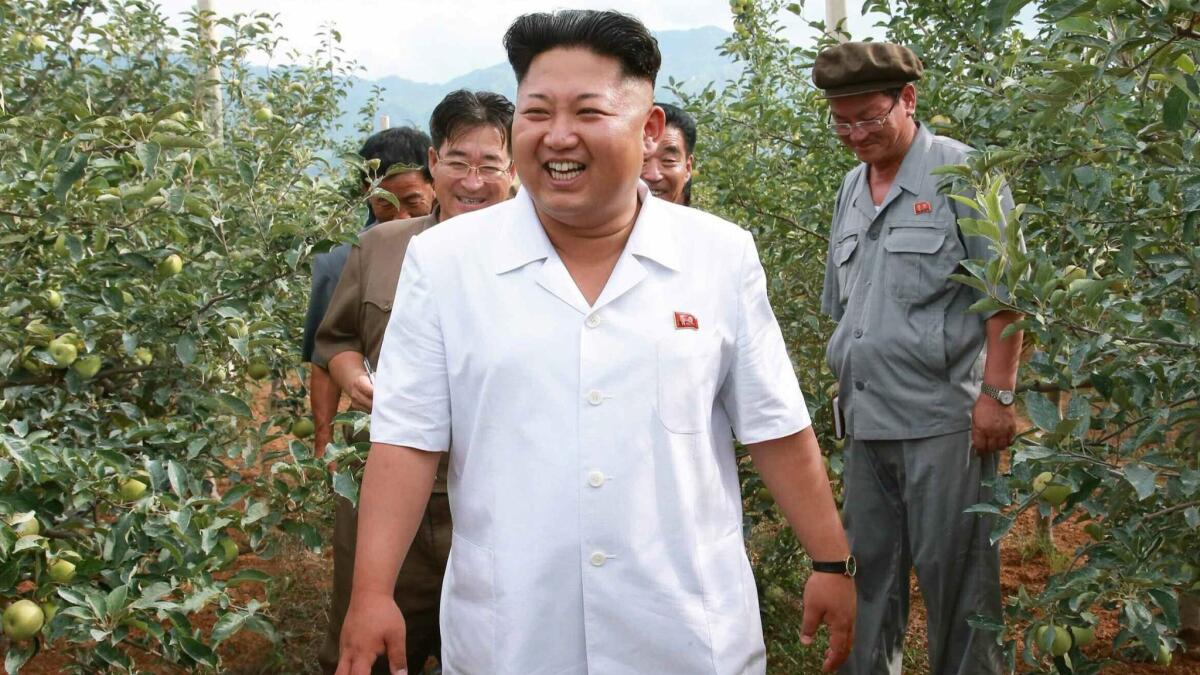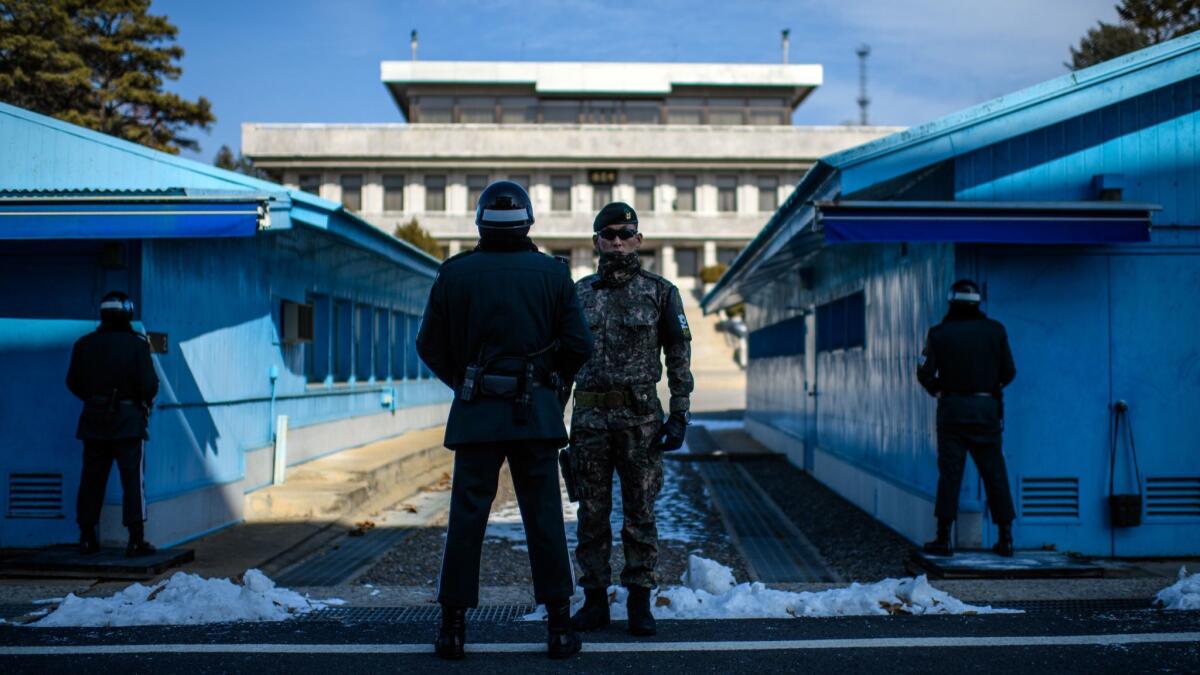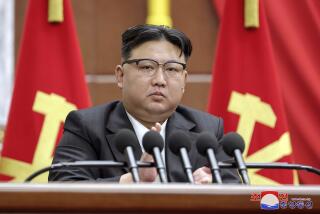Summits would expose North Korea’s Kim Jong Un to scrutiny he’s never experienced

In the next several weeks, North Korean leader Kim Jong Un could take historic steps toward peace on a long-divided peninsula, attending a highly anticipated summit with his counterpart from South Korea, and perhaps one soon after with President Trump.
For some, Kim’s actual, physical steps are also important.
In addition to watching for signs that the reclusive leader is willing to discuss his nation’s alarming rise as a nuclear state, Korea experts hope a potentially unscripted setting could offer valuable clues about his leadership, personality — and health.
The planned summit next month with South Korean President Moon Jae-in, scheduled for a diplomatic outpost on their shared border within the demilitarized zone, could offer a trove of fresh details about the North Korean leader.
“North Korea is such a data-poor area,” said Melissa Hanham, a senior research associate with the James Martin Center for Nonproliferation Studies in Monterey, who studies imagery for clues about North Korea’s emerging nuclear and missile programs. “Every bit of information we get, we try to use as well as we can.”
Kim is rarely, if ever, photographed by outsiders, and his image in state media is as tightly controlled as that of any leader in the world.

So the summit offers the possibility — though the details remain murky — that Kim might be recorded on video, even shown live, while walking to meet with Moon at the Peace House, the planned summit location on the South Korean side of the truce village known as Panmunjom.
The young leader, thought to be 34 and about 5 feet 6, has grown quite heavy during his six years in power, leading some to wonder whether he might suffer from diabetes or gout. (His grandfather and North Korea’s patriarch, Kim Il Sung, had a massive growth at the back of his neck that was largely shielded from cameras over the years.)
Korea experts will watch Kim’s steps, but also be closely monitoring other details, such as whether the leader wears a Western-style suit, as he did during a recent New Year’s Day speech, or sticks to his customary Mao-inspired outfits.
Kim’s body language and interaction with aides — and leaders representing longtime adversaries — could also offer valuable clues about his leadership.
“There is so much that we can learn,” said Jenny Town, assistant director of the U.S.-Korea Institute at the Johns Hopkins School of Advanced International Studies.
Details about the meeting remain unclear, as does the possibility of resolving the thorny disputes between the two sides. The North’s ballistic missile and nuclear weapons programs will be a central discussion point, and the presence of the United States, a key South Korean ally, on the peninsula is likely to factor into the talks.
The diplomatic meeting between Moon and Kim, which could be followed in May with a historic summit with Trump, was made possible in large part because of the Winter Olympics — an event that offered a preview of the possible images to come.
In his New Year’s address, Kim declared his nation a modern nuclear power, able — but not eager — to strike the United States. He also made a plea for participation in the Games, held in Pyeongchang, South Korea, which led to a flurry of diplomatic niceties not seen on the peninsula for a decade.
The negotiations over the Olympics, in which the North and South marched together and fielded a joint women’s hockey team, offered a potential preview of the theater that’s possible during the upcoming summit.
The first round of Olympic talks, for example, also occurred at the Peace House, which was built for such meetings. It is inside the demilitarized zone, a buffer that has separated the two nations since a 1953 armistice ended the Korean War.
The area is known for the close proximity of troops from North and South and the United Nations Command, which is controlled by the United States.
To get there, North Korean diplomats had to trek several hundred yards from their side, on a narrow, gravel-covered walkway that separates sky-blue huts used for military talks. (Their counterparts from the South made a similar trek from the opposite direction for talks on the North’s side several days later).

Both groups stepped over a speed-bump-sized concrete border marker, greeted their counterparts, and made their way to the talks — all under the watchful eye of soldiers, American surveillance equipment and international reporters.
“That was one of the most amazing visuals: the North Koreans striding over that concrete line that divides the two countries,” said Martyn Williams, a writer for the North Korea Tech website who records the government’s state broadcasts via satellite at his San Francisco-area home. “I found it quite remarkable to see.”
“To see Kim Jong Un do that would be even more remarkable,” he said.
Moon’s office has a committee planning the details that met again Wednesday. The president’s staff said the Peace House location, for now, has been settled. How Kim will get there is less clear.
“If he steps over that line, and actually walks to the Peace House, that’s a photo op that might actually bring tears to my eyes,” said Hanham, who has, with her colleagues, used Kim’s height to estimate the size of objects — missile launchers, warheads, etc. — captured in state photographs.
Some, including Hanham, are skeptical that the North would allow Kim to walk the distance.
“They are going to try to control the optics of this meeting,” said Town, also the managing editor of 38 North, a must-read journal for Korea experts.
Still, Kim must get to the building somehow, and the route remains a mystery.
The geography of Panmunjom, a sparsely populated outpost that straddles the highly fortified border between the North and the South, limits Kim’s options.
There are few roads in the immediate area that lead into the base, which is surrounded by rice fields and land mines, and no known tunnels between North Korean buildings and the Peace House. It’s unclear whether driving from the North to the South directly at the site is possible. Recently, a North Korean soldier got stuck in a military vehicle there while defecting to the South. (He eventually made it across the border on foot, although only after being shot by his former comrades.)
Kim could also enter South Korea from another border crossing and drive into Panmunjom by taking the same route as Moon. His motorcade could then drive directly to the summit building. Alternatively, the two leaders could meet at another location and drive or fly by helicopter together.
Even if access to Kim is limited, some unfiltered imagery should come from the summit. That means experts like Hanham will be less inhibited by the staging or digital editing that often masks details in North Korea’s official photographs.
One of her colleagues once discovered a photo in which a bump or lesion near Kim’s ear, often removed using software, had been allowed to remain visible. The analysts, by studying which aides attend, can also learn their order in lines of authority and their proximity to their boss.
“It’s totally fascinating,” Hanham said.
ALSO
Whatever comes next, North Korea’s Kim Jong Un can claim a win against Trump
With Xi in office for the long haul, China touts its stability — ‘the opposite of Washington, D.C.’
Southeast Asian leaders urge tough stance on North Korea
Stiles is a special correspondent.
More to Read
Start your day right
Sign up for Essential California for news, features and recommendations from the L.A. Times and beyond in your inbox six days a week.
You may occasionally receive promotional content from the Los Angeles Times.







